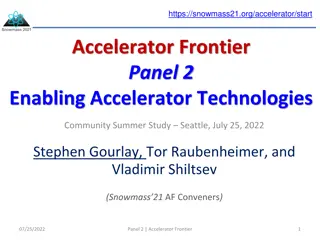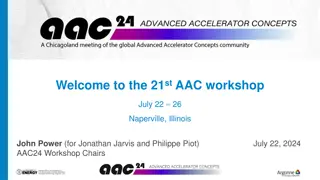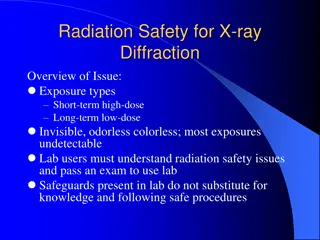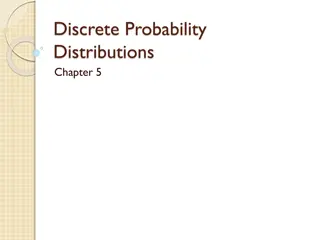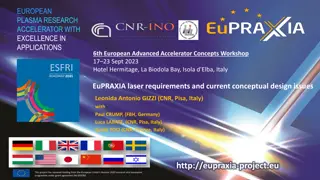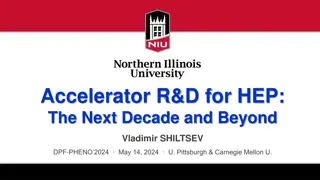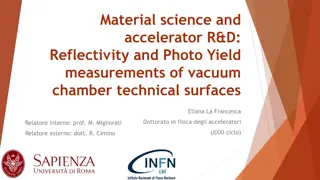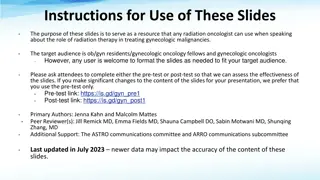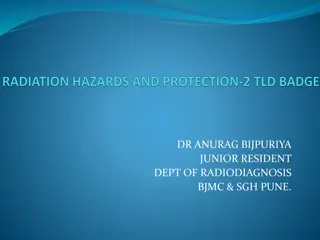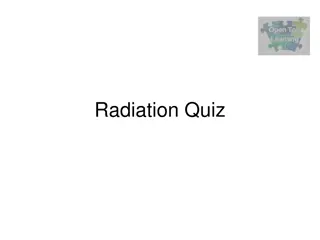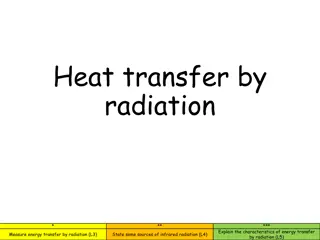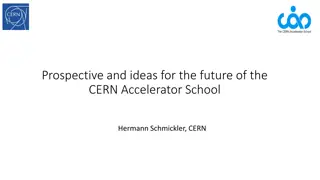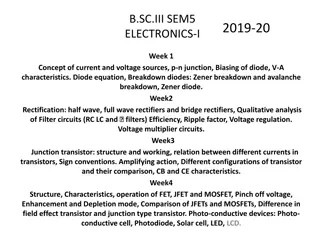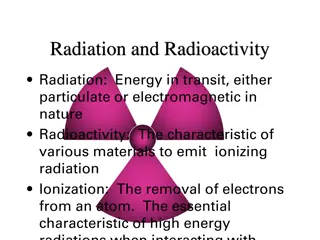Comprehensive Overview of Radiation Distributions in Accelerator Physics
Explore the intricate calculations and theoretical frameworks of radiation distributions in the context of pulsed high-field strength lasers interacting with electrons, covering topics such as Thomson scattering, undulators, and historical developments in the field. The discussion delves into the nuances of electron motion affected by field strength variations, leading to red-shift detuning, Doppler shifts, and transverse dipole emission, offering insights into the complex physics involved.
Download Presentation

Please find below an Image/Link to download the presentation.
The content on the website is provided AS IS for your information and personal use only. It may not be sold, licensed, or shared on other websites without obtaining consent from the author. Download presentation by click this link. If you encounter any issues during the download, it is possible that the publisher has removed the file from their server.
E N D
Presentation Transcript
Accelerator Physics Radiation Distributions S. A. Bogacz, G. A. Krafft, S. DeSilva, B. Dhital Jefferson Lab Old Dominion University Lecture 8 USPAS Accelerator Physics January 2020
Nonlinear Thomson Scattering Many of the the newer Thomson Sources are based on a PULSED laser (e.g. all of the high-energy lasers are pulsed by their very nature) Have developed a general theory to cover radiation distribution calculations in the general case of a pulsed, high field strength laser interacting with electrons in a Thomson scattering arrangement. The new theory shows that in many situations the estimates people do to calculate flux and brilliance, based on a constant amplitude models, need to be modified. The new theory is general enough to cover all 1-D undulator calculations and all 1- D pulsed laser Thomson scattering calculations. The main new physics that the new calculations include properly is the fact that the electron motion changes based on the local value of the field strength squared. Such ponderomotive forces (i.e., forces proportional to the field strength squared), lead to a red-shift detuning of the emission, angle dependent Doppler shifts of the emitted scattered radiation, and additional transverse dipole emission that this theory can calculate. USPAS Accelerator Physics January 2020
Ancient History Early 1960s: Laser Invented Brown and Kibble (1964): Earliest definition of the field strength parameters K and/or a in the literature that I m aware of eE eB = = 0 mc 0 0 mc 0 Undulators 2 Thomson Sources a K 2 2 Interpreted frequency shifts that occur at high fields as a relativistic mass shift . Sarachik and Schappert (1970): Power into harmonics at high K and/or a . Full calculation for CW (monochromatic) laser. Later referenced, corrected, and extended by workers in fusion plasma diagnostics. Alferov, Bashmakov, and Bessonov (1974): Undulator/Insertion Device theories developed under the assumption of constant field strength. Numerical codes developed to calculate real fields in undulators. Coisson (1979): Simplified undulator theory, which works at low K and/or a, developed to understand the frequency distribution of edge emission, or emission from short magnets, i.e., including pulse effects USPAS Accelerator Physics January 2020
Coissons Spectrum of a Short Magnet Coisson low-field strength undulator spectrum* ( ) 2 er c dE ( ) ( ) 2 2 = + + 2 2 2 2 2 2 2 1 1 /2 f B d d = + 2 2 2 f f f 1 = sin f ( ) 2 + 2 2 1 + 2 2 1 1 1 = cos f ( ) 2 2 2 + 2 2 1 *R. Coisson, Phys. Rev. A 20, 524 (1979) USPAS Accelerator Physics January 2020
Dipole Radiation Assume a single charge moves in the x direction ) , , , ( ( ( ) t ) ( ) ( ) z y = x y z t e x d ( ) t ( ( ) t ) ( ) ( ) z y d = x ( , , , ) J x y z t e x d Introduce scalar and vector potential for fields. Retarded solution to wave equation (Lorenz gauge), ( ) ' ' t = R r r + 1 R ( ' t / ) R c e t R c ( ) = = , ', ' ' ' ' r t r t dx dy dz dt 4 R 0 ( ) + ' ( ' t / ) d t t R c 1 R e R c ( ) = = 0 , ', ' ' ' ' A r t J r t dx dy dz dt x x 4 R e R A t ( ) = = = 0 , lim r lim r / B A B d t R c E 4 1 USPAS Accelerator Physics January 2020
Dipole Radiation ) sin ( / ed t r c cr = 0 lim r B x 4 1 r ( ) / ed t r c c r = z lim r sin E 2 4 0 1 y ( c r ) 2 2 / e d t r c 1 E B = = 2 r sin I 2 3 2 16 0 0 ( ) 2 2 / e d t c r c 1 dI d = 2 sin 2 3 16 0 = x r n Polarized in the plane containing and USPAS Accelerator Physics January 2020
Dipole Radiation Define the Fourier Transform ( ) t d d With these conventions Parseval s Theorem is ( ) 2 2 2 2 3 0 16 d c ~ 1 ~ ( ) d = i t = i t ( ) d t d e ( ) e dt 2 ~ 1 2 ( ) d = 2 dt d t d 2 dE e e 2 ( ) ( ) = = 4 / d t r c dt d d 3 3 32 c 0 2 ( ) 2 4 e d 1 dE = 2 sin Blue Sky! 3 3 32 d d c 0 This equation does not follow the typical (see Jackson) convention that combines both positive and negative frequencies together in a single positive frequency integral. The reason is that we would like to apply Parseval s Theorem easily. By symmetry, the difference is a factor of two. USPAS Accelerator Physics January 2020
Dipole Radiation For a motion in three dimensions 2 ( ) 2 4 e d n 1 dE = 3 3 32 d d c 0 Vector inside absolute value along the magnetic field ( 3 3 0 32 d d c ) ) 3 ( 2 2 ( ) ( ) ( ) n d 2 4 2 4 e d n n e n d 1 1 dE = = 3 32 c 0 Vector inside absolute value along the electric field. To get energy into specific polarization, take scalar product with the polarization vector USPAS Accelerator Physics January 2020
Co-moving Coordinates Assume radiating charge is moving with a velocity close to light in a direction taken to be the zaxis, and the charge is on average at rest in this coordinate system For the remainder of the presentation, quantities referred to the moving coordinates will have primes; unprimed quantities refer to the lab system x ' x z c , z ' z ' y y In the co-moving system the dipole radiation pattern applies USPAS Accelerator Physics January 2020
New Coordinates ' x ' x ' ' ' n ' ' n ' ' ' ' ' z ' z ' ' y ' y Resolve the polarization of scattered energy into that perpendicular ( )and that parallel ( ) to the scattering plane sin ' ' cos ' sin ' = = z n z n e = + ' ' + = ' ' ' sin cos n x y z ' ' ' ' ' ' / ' ' ' ' sin cos x y ' = = ' ' + ' ' ' ' = ' e ' e ' cos ' cos cos ' sin sin n x y z USPAS Accelerator Physics January 2020
Polarization It follows that ( ) ( ) ' ' ' e ~ d ~ d ~ d ( ) ( ) ( ) = ' e ' ' ' ' sin ' ' ' cos ' x y ~ d ~ d ~ d ~ d ( ) ( ) ' = + ' ' cos ' cos ' ' ' cos ' sin ' sin ' ' x y z So the energy into the two polarizations in the beam frame is ' 2 4 1 ' dE e 2 ( ) ( ) = ' sin ' ' cos ' ' ' d d x y 3 3 ' ' 32 d d c 0 2 ( ) ( ) ' ) ' cos 'cos ' + ' cos 'sin ' ' ' d d ' 2 4 1 ' dE e x y = ( 3 3 ' ' 32 d d c sin ' ' d 0 z USPAS Accelerator Physics January 2020
Comments/Sum Rule There is no radiation parallel or anti-parallel to the x-axis for x-dipole motion In the forward direction ' 0, the radiation polarization is parallel to the x-axis for an x-dipole motion One may integrate over all angles to obtain a result for the total energy radiated ( ( 0 ' 32 d c ) ' 2 4 1 ' dE d e 2 2 ( ) ( ) = + ' ' ' ' 2 d d x y 3 3 ' 32 c 0 ) ' 2 4 1 ' 2 8 dE e 2 2 2 ( ) ( ) ( ) = + + ' ' ' ' ' ' d d d x y z 3 3 3 3 2 ( ) 2 4 ' ' ' e d ' 1 8 dE d = tot Generalized Larmor 3 3 ' 32 3 c 0 USPAS Accelerator Physics January 2020
Sum Rule Total energy sum rule 2 ( ) 2 4 ' ' ' e d 1 = ' ' E d tot 2 3 12 c 0 Parseval s Theorem again gives standard Larmor formula ( ) t ( ) t 2 2 2 2 ' ' ' ' e d e a ' 1 1 dE dt = = = ' tot P 3 3 ' 6 6 c c 0 0 USPAS Accelerator Physics January 2020
Energy Distribution in Lab Frame ( ( ) ) 2 ( ( ) ) ( ) 2 ' d 1 cos sin 2 4 2 1 cos e dE d d x = 3 3 c 32 ' 1 cos cos d y 2 cos 1 cos 1 ( ) ( ) ' d 1 cos cos x cos ( ) 2 2 4 2 1 cos e dE d d ( ) ( ) = + ' 1 cos sin d y 3 3 c 32 cos sin ( ) ( ) ' 1 cos d ( ) z 1 cos By placing the expression for the Doppler shifted frequency and angles inside the transformed beam frame distribution. Total energy radiated from d'z is the same as d'x and d'y for same dipole strength. USPAS Accelerator Physics January 2020
Bend Undulator Wiggler e e e [ph/s/mm2/mr2/0.1%bw] Flux [ph/s/0.1%bw] Flux [ph/s/0.1%bw] Brightness white source partially coherent source powerful white source USPAS Accelerator Physics January 2020
Weak Field Undulator Spectrum ( ) '/ ~ B c ec mc ( ) k ( ) z ( ) ( ) = ikz B B e dz = = z x x ' ' ' ' d d 2 ' 4 e ( ) 2 r 2 ( ) 1 c os / B c 2 e dE d d r c 2 2 0 2 4 16 m c z z = 2 0 2 sin e ( ) 2 2 1 co s z ( ) 2 ( ) 2 1 c o s / B c 2 cos 1 dE d d r c z z = 2 0 2 cos e z ( ) 2 co s 2 1 co s z z + 2 2 1 1 ( )( ) 0 + + + 2 1 cos 1 2 2 z z 2 2 Generalizes Coisson to arbitrary observation angles USPAS Accelerator Physics January 2020
Strong Field Case Why is the FEL resonance condition? 2 K = + 1 0 2 2 2 d = 0 dt d dt = m c ec B z e mc ( ) z ( ) ' B z dz = ' x USPAS Accelerator Physics January 2020
High K 1 ( ) z ( ) z = 2 1 z x 2 2 z 2 2 1 1 2 1 e mc K K ( ) z ( ) B z dz ( ) = + 1 ' ' 1 1 cos 2 k z 0 z 2 2 2 2 2 2 4 Inside the insertion device the average (z) velocity is + 1 2 1 K = * 1 z 2 2 2 and the radiation emission frequency redshifts by the 1+K2/2 factor USPAS Accelerator Physics January 2020
Thomson Scattering Purely classical scattering of photons by electrons Thomson regime defined by the photon energy in the electron rest frame being small compared to the rest energy of the electron, allowing one to neglect the quantum mechanical Dirac recoil on the electron In this case electron radiates at the same frequency as incident photon for low enough field strengths Classical dipole radiation pattern is generated in beam frame Therefore radiation patterns, at low field strength, can be largely copied from textbooks Note on terminology: Some authors call any scattering of photons by free electrons Compton Scattering. Compton observed (the so-called Compton effect) frequency shifts in X-ray scattering off (resting!) electrons that depended on scattering angle. Such frequency shifts arise only when the energy of the photon in the rest frame becomes comparable with 0.511 MeV. Krafft, G. A. and G. Priebe, Rev. Accel. Sci. and Tech., 3, 147 (2010) USPAS Accelerator Physics January 2020
Simple Kinematics e- = z Beam Frame Lab Frame ( ) ( ) = 2 z , ep mc = 2 ' ,0 p mc e ( ) ( ) = + = y z 1,sin cos p E ' ' , L ' p E E p L p L ( ) = = L 2 2 ' 1 cos p p mc E mc E e p L USPAS Accelerator Physics January 2020
( ) = L ' 1 cos E E L In beam frame scattered photon radiated with wave vector ' E ( , 1 ) ' = ' sin ' cos , ' sin ' sin , ' cos L k c Back in the lab frame, the scattered photon energy Es is ' E ( ) = + = ' 1 cos ' L E E ( ) s L 1 cos ( ( ) ) 1 1 cos cos = E E s L USPAS Accelerator Physics January 2020
Electron in a Plane Wave Assume linearly-polarized pulsed laser beam moving in the direction (electron charge is e) z y ninc cos sin + = ( ) ( ) ( )x A = x , sin cos A x t A ct y z inc x Polarization 4-vector (linearly polarized) ( ) 0 , 0 , 1 , 0 = Light-like incident propagation 4-vector ( , 0 , 1 ) inc = sin , cos n = = = 0 n n n inc inc inc Krafft, G. A., Physical Review Letters, 92, 204802 (2004), Krafft, Doyuran, and Rosenzweig , Physical Review E, 72, 056502 (2005) USPAS Accelerator Physics January 2020
Electromagnetic Field A A = = F A A x x ( ) dA ( ) inc inc = n n d Our goal is to find x ( )=(ct( ),x( ),y( ),z( )) when the 4-velocity u ( )=(cdt/d ,dx/d ,dy/d ,dz/d )( ) satisfies du /d = eF u /mc where is proper time. For any solution to the equations of motion. ( = = d Proportional to amount frequencies up-shifted in going to beam frame ) d n u ( ) inc = 0 n F u n u n u inc inc inc USPAS Accelerator Physics January 2020
is proportional to the proper time On the orbit ( ) ( ) ( ) = d d = / ct n x n u inc inc Integrate with respect to instead of . Now ( d ) d u df d ( ( ) ) = = c n u c f inc d d where the unitless vector potential is f( ) = eA( )/mc. ( ) = u cf u USPAS Accelerator Physics January 2020
Electron Orbit ( ) ( ) ( n 2 2 u c f ( ) ( ) ( ) inc inc = + + u u cf n n ( ) ( ) ) 2 u n u inc inc Direct Force from Electric Field Ponderomotive Force ( ( ) ) ( u ) c u u u c ( ) ( ) inc = + d ' ' x n f ( ) ( ) ( ) 2 n n n u inc inc inc ( ) 2 inc 2 2 ' c n f + d ' ( ) ( ) 2 n u inc USPAS Accelerator Physics January 2020
Energy Distribution ( ) 2 ; , sin D t 2 2 dE d d e = sin ( ) 3 3 c ; , cos D 32 ( ) p 1 cos 2 cos 1 ( ) ; , cos D t cos 2 2 sin cos 1 dE d d e ( ) = + ; , sin D ( ) p 3 3 c 32 1 cos cos cos cos sin ( ) + ; , D ( ) p 1 1 cos USPAS Accelerator Physics January 2020
Effective Dipole Motions: Lab Frame ( ) mc eA 1 ( ) ( ) , ; , i = ; , D e d ( ) t 1 cos ( ) 2 2 m c 2 2 e A 1 ( ) ( ) , ; , i = ; , D e d ( ) p 1 cos 2 And the (Lorentz invariant!) phase is = + ( ( ) ) ( ) mc 1 1 cos c os ' eA sin cos 1 ' d ( ) cos ( ) , ; , ( ) 2 2 m c 2 2 c ' 1 sin sin sin cos cos e A ' d ( ) 2 2 2 1 co s USPAS Accelerator Physics January 2020
Summary Overall structure of the distributions is very like that from the general dipole motion, only the effective dipole motion, including physical effects such as the relativistic motion of the electrons and retardation, must be generalized beyond the straight Fourier transform of the field At low field strengths (f <<1), the distributions reduce directly to the classical Fourier transform dipole distributions The effective dipole motion from the ponderomotive force involves a simple projection of the incident wave vector in the beam frame onto the axis of interest, multiplied by the general ponderomotive dipole motion integral The radiation from the two transverse dipole motions are compressed by the same angular factors going from beam to lab frame as appears in the simple dipole case. The longitudinal dipole radiation is also transformed between beam and lab frame by the same fraction as in the simple longitudinal dipole motion. Thus the usual compression into a 1/ cone applies USPAS Accelerator Physics January 2020
Weak Field Thomson Backscatter With = and f <<1 the result is identical to the weak field undulator result with the replacement of the magnetic field Fourier transform by the electric field Fourier transform Undulator Thomson Backscatter ~ ( ) ( ( ) ( ( ) ) ) ( ) + 1 cos / cB c 1 cos / 1 E c Driving Field y z z x z z Forward Frequency 0 0 2 4 2 2 Lorentz contract + Doppler Double Doppler USPAS Accelerator Physics January 2020
Photon Number Spectrum = 0 = sin = 1/ dN/dE Compton Edge 0 (1+ ) 2Elaser (1+ ) 2 2Elaser E USPAS Accelerator Physics January 2020
High Field Thomson Backscatter For a flat incident laser pulse the main results are very similar to those from undulaters with the following correspondences Undulator Thomson Backscatter a K Field Strength + 1 + 1 2 2 K a Forward Frequency 0 0 2 2 2 2 4 2 + + * cos ' 1 cos ' Transverse Pattern z NB, be careful with the radiation pattern, it is the same at small angles, but quite a bit different at large angles USPAS Accelerator Physics January 2020
Forward Direction: Flat Laser Pulse 20-period equivalent undulator: ( 0 1 z + ) ( ) ( ) ( ( ) = A cos 2 / 20 Ax 0 0 0 ) 2 = 2 2 2 / 4 2 / , / c c a eA mc 0 0 0 USPAS Accelerator Physics January 2020
( 1 ) 2 / + 2 / 1 a USPAS Accelerator Physics January 2020
Realistic Pulse Distribution at High a In general, it s easiest to just numerically integrate the lab- frame expression for the spectrum in terms of Dt and Dp. A 105 to 106 point Simpson integration is adequate for most purposes. Flat pulses reproduce previously known results and to evaluate numerical error, and Gaussian amplitude modulated pulses. One may utilize a two-timing approximation (i.e., the laser pulse is a slowly varying sinusoid with amplitude a( )), and the fundamental expressions, to write the energy distribution at any angle in terms of Bessel function expansions and a integral over the modulation amplitude. This approach actually has a limited domain of applicability (K,a<0.1) USPAS Accelerator Physics January 2020
Forward Direction: Gaussian Pulse ( ) ( ) ( . 8 2 ) ( ) = 2 / a eA mc = 2 exp / 156 cos 2 / A A z peak peak 0 0 x peak Apeakand 0chosen for same intensity and same rms pulse length as previously USPAS Accelerator Physics January 2020
Radiation Distributions: Backscatter Gaussian Pulse at first harmonic peak 1.5 10-41 1.5 1.5 10-41 1.5 1 10-41 1 1 10-41 1 dE d dE d 5 10-42 5 10 5 10-42 5 10 d d 0 0 0 0 -0.05 -0.05 1 2 -0.5 -0.5 -0.025 -0.025 0 0 0 0 0 0 x x y 0.025 0.025 0.5 0.5 -2 -1 0.05 0.05 Courtesy: Adnan Doyuran (UCLA) USPAS Accelerator Physics January 2020
Radiation Distributions: Backscatter Gaussian at first harmonic peak 1.5 10-41 1.5 10-41 1 10-41 1 1 10-41 1 dE d 5 10-42 5 10 5 10-42 5 dE d d d 0 0 0 0 -0.05 -0.05 2 -0.5 -0.5 0.5 -0.025 -0.025 0 0 0 0 0 0 x x y 0.025 0.025 0.5 0.5 -0.5 -2 0.05 Courtesy: Adnan Doyuran (UCLA) USPAS Accelerator Physics January 2020
Radiation Distributions: Backscatter Gaussian at second harmonic peak 6 10-43 4 10-43 dE d 2 10-43 d 0 -2 -2 2 0 0 0 x x y 2 2 -2 Courtesy: Adnan Doyuran (UCLA) USPAS Accelerator Physics January 2020
90 Degree Scattering 2 2 2 1 dE d d e ( ) ( ) = ; , sin ; , cos D D t p 3 3 c 32 2 cos 1 ( ) ; , cos D t cos 2 2 1 cos 1 dE d d e ( ) = + ; , sin D p 3 3 c 32 cos sin ( ) + ; , D ( ) p 1 cos USPAS Accelerator Physics January 2020
90 Degree Scattering ( ) mc eA 1 ( ) ( ) = , ; , i ; , D e d t ( ) 2 2 m c 2 2 e A 1 ( ) ( ) = , ; , i ; , D e d p 2 And the phase is ( ) mc ' sin cos eA ( ) 1 cos ' d ( ) = , ; , ( ) 2 2 m c c 2 2 ' e A 1 sin sin + ' d 2 2 USPAS Accelerator Physics January 2020
Radiation Distribution: 90 Degree Gaussian Pulse at first harmonic peak 8 10-42 8 10-42 6 10-42 6 6 10-42 4 10-42 d 4 10-42 4 dE d dE d d 2 10-42 2 10 2 10-42 0 0 0 -0.5 -0.5 0.5 2 -0.005 -0.005 0 0 0 0 0 0 x x y 0.005 0.005 -2 0.5 0.5 -0.5 Courtesy: Adnan Doyuran (UCLA) USPAS Accelerator Physics January 2020
Radiation Distributions: 90 Degree Gaussian Pulse at first harmonic peak 8 10-42 8 10-42 6 10-42 6 10-42 4 10-42 dE d d 4 10-42 dE d d 2 10-42 2 10-42 0 -0.4 -0.4 0.4 0 -0.004 -0.004 -0.2 -0.2 0.2 2 -0.002 -0.002 0 0 0 x x y 0 0 0 0.2 0.2 -0.2 0.002 0.002 0.4 0.4 -0.4 -2 0.004 0.004 Courtesy: Adnan Doyuran (UCLA) USPAS Accelerator Physics January 2020
Polarization Sum: Gaussian 90 Degree 8 10-42 6 10-42 6 4 10-42 4 dE d d 2 10-42 2 10 0 0 -0.5 -0.5 0.5 0 0 0 x x y 0.5 0.5 -0.5 Courtesy: Adnan Doyuran (UCLA) USPAS Accelerator Physics January 2020
Radiation Distributions: 90 Degree Gaussian Pulse second harmonic peak 1.5 10-45 2 10-45 1 10-45 dE d 1.5 10-45 dE d 1 10-45 5 10-46 d 5 10-46 d 0 0 -1 -1 1 -1 -1 1 -0.5 -0.5 0.5 -0.5 -0.5 0.5 0 0 0 0 0 0 x x y x x y 0.5 0.5 -0.5 0.5 0.5 -0.5 1 1 -1 1 1 -1 Second harmonic emission on axis from ponderomotive dipole! Courtesy: Adnan Doyuran (UCLA) USPAS Accelerator Physics January 2020
Compensating the Red Shift Add possibility of frequency modulation (Ghebregziabher, et al.) ( ) ( ) ( ) ( ) = cos 2 / x A a f Wave phase ( ) = 2 / f Wave (angular) frequency and wave number ( ) ( ) = = k t z USPAS Accelerator Physics January 2020
Double Doppler to Constant Frequency In beam frame ( ) ( ) = + = + * * * * 1 1 k k ( ) 2 ( ) 2 2 2 a a 1 = + = + *2 *2 2 1 1 / 1 2 Doppler shift to lab frame ( =0) ( 1 + d d d d ) 2 ( ) ( ) 2 = = + = * *2 2 1 C Compensation occurs when 1 a ( ) ( ) = + 2 / 2 f a d + 2 0 1 / 2 0 USPAS Accelerator Physics January 2020
Compensation By Chirping Terzic, Deitrick, Hofler, and Krafft, Phys. Rev. Lett., 112, 074801 (2014) USPAS Accelerator Physics January 2020
Hajima, et al. Uranium Detection Hajima, et al., NIM A, 608, S57 (2009) TRIUMF Moly Source? USPAS Accelerator Physics January 2020
THz Source USPAS Accelerator Physics January 2020
Radiation Distributions for Short High-Field Magnets ( ) ; , = t D a / a z ( ) ( ) 0 exp , ; , z i dz ( ) z 2 z 2 2 0 / 0 1 1 ( ) ( ) = ; , exp , ; , z D i dz ( ) z p 0 z z And the phase is ( ) z 1 cos c z 1 1 ( ) = + 0 z , ; , z ' dz ( ) z ' c 0 0 z z z ( ) a z z ' / sin cos c 0 ' / '. dz ( ) z 2 z 2 2 0 a 0 Krafft, G. A., Phys. Rev. ST-AB, 9, 010701 (2006) USPAS Accelerator Physics January 2020




